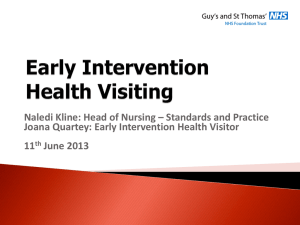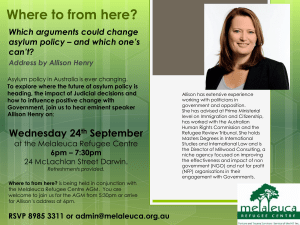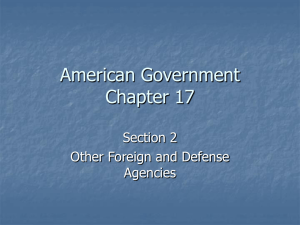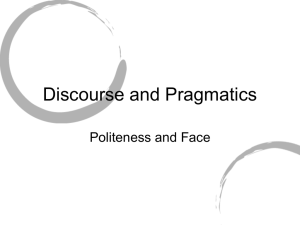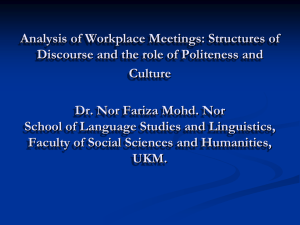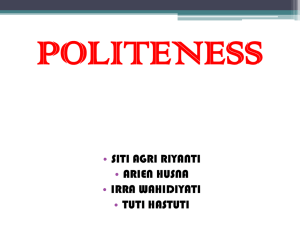Vulnerable Speakers ppt
advertisement
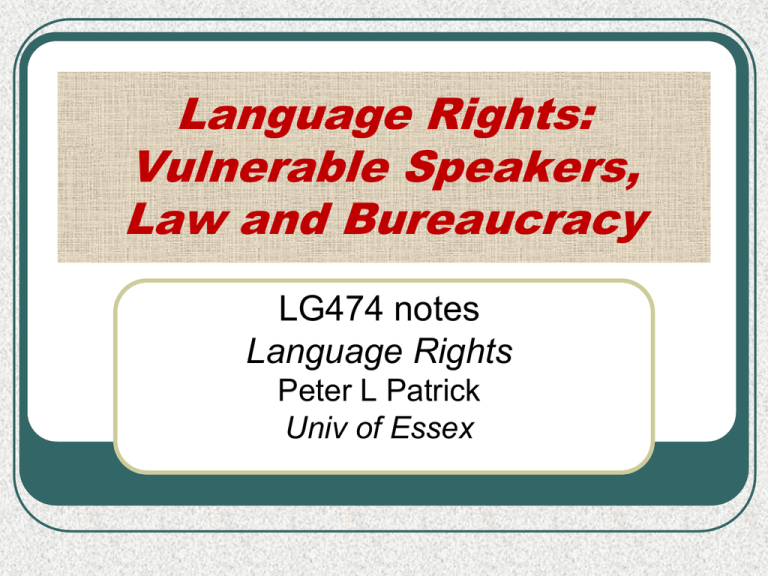
Language Rights: Vulnerable Speakers, Law and Bureaucracy LG474 notes Language Rights Peter L Patrick Univ of Essex Language and Power, I 1960s/70s research attributed power as institutional: members (just) exert power as representatives of it. Later studies suggest power manifested thru socioeconomic factors: age, gender, rank… • Bias within legal system towards certain categories (male, white, educated, middle class, citizens) Current research: power a dynamic property, created, maintained, exerted thru interaction Language and Power, II Language is a primary mode of action for power Inequality is the primary effect of power in action Language is used to create/sustain/exercise power Power+inequality influence language structure+use Discourse= language-in-action, in the round: social/ cultural/historical/economic patterns, developments Institutions have a dominant language/culture thru which cases are viewed & power is exercised Other voices are vulnerable to silencing & distortion Claiming Power via Interaction, I What discourse practices function as modes of power & entextualisation in institutional interactions? Key communicative practices used to maintain power in consultations: 1. Question Use 2. Topic Control 3. Evaluation of Responses Also critical in asylum interviews, legal testimony Claiming Power via Interaction, II When speech is linked to particular contexts, assigned a privileged ‘reading’ – evaluated, it gets embedded in power – and all of this transmitted… It is then transformed/reduced by entextualisation. Inc. transcripts/sumaries of e.g. asylum interviews, witness statements, courtroom testimony – talk becomes evidence in reports & legal documents. How are people’s identities & stories represented & transformed in decision-making contexts? Who are vulnerable speakers? People in some circumstances are more vulnerable to having their speech be silenced, distorted or ignored. This is esp. true in bureaucratic/institutional contexts which both restrict the speech of people, then claim the right to interpret it & make decisions based (partly) on it. The classic example of this is witnesses in criminal court. Law & legal process are entirely linguistic performances. Some categories of speakers are recognised in UK law as “vulnerable” persons when giving witness testimony. My notion of “vulnerable speakers” thus generalizes from witnesses to speakers, from the UK to rest of world. Vulnerable Witnesses in the UK, I Persons recognised include “children, rape victims, persons with intellectual disability, & those who are linguistically challenged such as non-native speakers of the language used in the legal context” (Luchjenbroers & Aldridge 2008) Categories later expanded to include “people who are likely to experience fear and/or distress as a result of social, cultural, religious, ethnic, or domestic issues… this final group includes victims of rape” Witnesses – but not suspects – can apply for special measures to be used in legal procedures; their use is not automatically granted except for children. Categories not recognised elsewhere, eg US, Australia… Vulnerable Witnesses in the UK, II Landmarks in the UK legal process: Systematic audio-recording of police interviews, 1980s Definition and protection of VWs given legal force • Achieving the best evidence in criminal proceedings: The interviewing of vulnerable and intimidated witnesses, including children (HO 2001) Later expanded definition of VW categories Special measures may include: screening the witness; (live) video, or private, evidence-taking; examination by intermediary; communication aids; no cross-exam by the accused in person; removing wigs & gowns; exclude mention of personal sexual history in court. Vulnerable Status & Settings Children & the very elderly as witnesses in court • • Children are already included as the only automatic category Elderly not included in UK law; must they qualify as disabled? People w/disabilities or mental illness in clinical settings • Incl. in court setting; don’t same issues apply in other contexts? Women as victims of violence, esp. rape, in legal contexts • Should rape be only type of domestic violence where measures apply? Ethnic minorities in standardized bureaucratic contexts • Not all minorities/contexts: “fear & distress”, no ref. to language issues People seeking asylum from immigration agencies, i.e. • Those who don’t qualify by age or disability, see last category above Vulnerable status/setting: Examples Land claim/native title cases, Australian Walsh (2008) English-speaking courts embrace Western ideologies Aboriginal witness must show traditional identity: Catch-22 More articulate = less “authentic”, but less articulate may be seen as unconvincing, reticent, unclear case Similar to asylum situation: ability to use English or major language (Swahili, Std Somali) may make Tribunal doubt claims to national, minority, or persecuted-group origin… Restriction to little-known language leaves AS at mercy of govt. interpreters and LADO agencies – poss. not using their native language/dialect –> invisible damage to case Gate-keeping vs Advocacy Widely recognized: we live in an “interview society” • Interaction w/bureaucracy often requires interviews (IVs), frequently cross-cultural (Gubrium & Holstein 2003) Gate-keeping: brief encounters b/w strangers where one has authority to affect the other’s future (Erickson & Shultz 1982) Advocacy: encourage a client to speak for herself, or provide her with a voice if she is unable to speak (Young 1993) • Contrasts w/counselor: external, not internal, needs of clients Institutional service providers often have to provide both roles in same interaction, & struggle to reconcile them Bureaucracy can either impose outcomes on victims, or empower victims to make their own choices Importance of Narration Victims desire to tell their story & be heard. How do we know? • Despite being told they’ve narrated enough (Trinch 2001), • or not to narrate at all (Jacquemet 2004), they keep telling Some victims of domestic violence never return to the law clinic where they gave their testimony, for the actual protective order (Trinch, 9/15 pro bono clinic) Victims resist the genre of 'report’… they prefer to tell their stories in the form of personal narratives • If what they wanted most was e.g. a PO, would they do this? Importance of Narration Narratives are teller-initiated and teller-driven, but Reports = recipient-elicited, recipient-driven (Polanyi ‘85) There’s also a subjective/objective contrast here: The legal system requires that victims’ suffering be translated into legally-relevant categories • They get reframed as refugees, witnesses, plaintiffs, etc. This institutional translation and reframing (i.e., entextualization) may be one major cause of alienating them as clients. From Advocate to Gate-Keeper, I Bureaucratic pressures of cost, time, policy: judged on efficiency, quantity (& results...) Asylum or domestic violence IV texts are thus formulaic, standardized both for form & content • Driven by bureaucratic or specialist (medical, legal) • • knowledge, and expectations of the genre, Bureaucrats – & even advocates (Trinch’s DA paralegals )– press clients to mould individual narratives into a successful institutional format (Ex. (13) on p. 18) “Z is my ex-boyfriend with whom I have one child. We have been separated for approx. 5 months… During our relationship of about 3 years, he has threatened & psychologically abused me” Entextualisation at Work This is not just a feature of final texts – ways of speaking characteristic of legal documents invade the IV itself as an oral gatekeeping device Clients co-operate in entextualization in order to proceed in and expedite the process, and so as not to alienate their advocate/gatekeeper (whose help is needed!) “Friendly” talk from advocates is used to elicit material for coding into institutional categories, which becomes part of the legal process From Advocate to GateKeeper, II Eliciting reports – rather than facilitating narratives: • • Extensive co-construction takes over agency from victim Routinization allows more cases to be processed quickly W/routinization, basic politeness features disappear GK role serves efficiency better than Advocate role • • • • Less alignment with client Therapeutic functions reduced or minimized Hidden nature of exchanges makes it unclear what speech is required from clients, increasing stress and deception Casts doubt on the social meanings of speech choices How to Succeed in Interviews while Really, Really Trying... For gate-keeping IVs to succeed as collaboration • (1) client must accept that Qs are valid, • (2) understand the questions & be capable of answering • (3) succeed in giving relevant answers, and also • (4) indicate awareness of framework that underlies them • (5) yet demonstrate sincerity at the same time • Result is a narrative which volunteers the correct & expected set of background assumptions – w/o betraying that one is playing a game w/rules... (Erickson & Shultz 1982; Cook-Gumperz & Gumperz 2002;Trinch 2001) Gate-Keeping vs Advocacy in Protective Order Interviews, I Context: Interviews in legal institutions assisting victims of domestic violence to obtain protective orders (Trinch 2001) Data from 2 settings: (i) District Attorney’s office with paralegal interviewers (6 of 7 are bilingual Latina women); (ii) pro bono legal clinic w/volunteers (none are Latino, all use interpreters to communicate with the clients). All victims are Latina women who use Spanish or codeswitch w/English. Final narrative is a written/composed one in PO cases (not necessary to ‘pass’ orally, as in asylum interviews) • Due to advocacy role, the IVer is on ‘same side’ as client Gate-Keeping vs Advocacy in Protective Order Interviews, II Gatekeeping tasks: • • determine client eligibility for PO; signal clients to adopt specific legal language in request, ie, entextualization of their narrative into affidavit to the court Advocacy tasks: • repackage a victim’s narrative account of abuse into • a client’s legally valid need/desire for a protective order. Analysis: • juxtaposes oral (recorded) narrative of abuse by client with written affidavit drafted by the legally-trained interviewer Research Questions (Trinch 2001) What linguistic devices are employed to manage dual Advocate/Gatekeeper identities? What can written texts tell us about interviewers' willingness to empower clients? How do social identities of IVers surface in the construction of discursive Advo/G-K identity? More generally, In interaction w/the legal system, what contributes to the feeling on the part of battered women and rape victims that they have been assaulted anew, blamed or at best unaccompanied in the process? Can we ask the same Q about asylum seekers? Analytic framework: Politeness & Interactional Discourse Analysis Context of advocacy and/or gatekeeping is constructed via contextualization cues (Gumperz) & social frameworks. Several frames may be in operation at the same time. Shifts in footing (∴ frame), i.e. alignment towards client or institution, serve to manage dual Advo/GK identities. Use of exclusive/inclusive pronouns to assert G-K institutional function: • • ¿Qué es que quieres que hagamos por tí? What is it that you want us to do for you? Exclusive pronoun use occurs in 9 of the 15 District Attorney IVs, emphasizing G-K role. Contrast: pro bono vs paralegals The pro bono clinic volunteers often use inclusive we (if ambiguously) to evoke solidarity with the client, portraying client and IVer as involved in joint effort: • (to interpreter) “Well we, we are, that’s what she’s here for, we’re going to get a restraining order to prevent him from coming within a hundred yards of her” (Trinch 2001, ex. 4) Pro bono IVers often explain why they strive for a fixed format; Latina paralegals tend not to give such accounts. Latter works to intensify authority and entrench G-K role. Analytic framework: Politeness Politeness – used to mitigate FTAs generally – functions to express advocacy goals. • • Positive politeness validates client’s feelings/concerns; Negative P empowers the client to be agentive. Politeness strategies employed for advocacy include: • • • • Claim common ground b/w interviewer and client Convey cooperation, joint action in a mutual enterprise Simply, succeed in fulfilling client’s need (=request PO) Allow people to tell stories in their own voices. Contrast: PO vs Asylum interviews In asylum IVs there is no advocacy role – only G-K ASs already know the ‘rules of the game’: • • Some have been interrogated with force back home Many are currently enmeshed in a series of interviews with the asylum-granting bureaucracy Overt objectives • • (Case-worker:) Extracting objective truth of fact, vs (Claimant:) Performance of personal veracity and morality Covert objectives • • (Case-worker:) Carrying out policy goals and ends, vs (Claimant:) Achieving freedom and safety Failure in Asylum Interviews Conditions of performance lead almost inevitably to failure, for which only the asylum seeker is blamed. • • • • • to understand what is required in bureaucratic interactions (in a foreign country); to successfully contest a choice of (non-native) language that is inappropriate for both participants and for the context, to maneuver for time to recall details of a complex narrative, to overcome the inequalities inherent in the setting, role relations and expectations of the interlocutors, to be aware of misinterpretations by the officials and correct them, to portray oneself in a favourable moral light through speech. Failure in Asylum Interviews AS lost in strange land w/o family, language, culture IVer equally subjective: rely on own morality, politics, cultural assumptions about nationality & monolingualism Basic condition of linguistic prejudice and inequality is met: negative moral judgment of AS, • • for selecting inappropriately from among the linguistic choices that lie open to them, even when the 'appropriate' choices are unrealistic or impossible. Argument: Asylum seekers are also vulnerable speakers Q: Where do the language rights of asylum seekers lie? References Birch, Diane. 2000. A better deal for vulnerable witnesses? Criminal Law Review (April): 223-249. Brown, Penelope & Stephen C. Levinson. 1987. Politeness: Some universals in language use. Cambridge University Press. Cook-Gumperz, Jenny &Gumperz, John J. 2002. Narrative accounts in gatekeeping interviews: Intercultural differences or common misunderstandings? Language and Intercultural Communication 2(1): 25–36. Erickson, Frederick & Jeffrey Shultz. 1982. The counselor as gatekeeper: Social interaction in interviews. NY: Academic Press. Gubrium, Jaber & James Holstein. 2003. From the individual interview to the interview society. In J Gubrium & J Holstein, eds., Postmodern interviewing. Home Office. 2001. Achieving the best evidence in criminal proceedings: The interviewing of vulnerable &intimidated witnesses, including children. HMSO. Jacquemet, Marco. 2004. Transcribing refugees: The entextualization of asylumseekers' hearings in a transidiomatic environment. Text and Talk, 29 (5): 525-546. References Luchjenbroers, June, & Michelle Aldridge, eds. 2008. Language and Vulnerable Witnesses across Legal Contexts. Journal of English Linguistics 36(3). Trinch, Shonna L. 2001. The advocate as gatekeeper: the limits of politeness in protective order interviews with Latina survivors of domestic abuse. Journal of Sociolinguistics 5(4): 475–506. Walsh, Michael. 2008. "Which way?" Difficult options for vulnerable witnesses in Australian Aboriginal land claim and native title cases. Journal of English Linguistics 36(3): 239-265.
